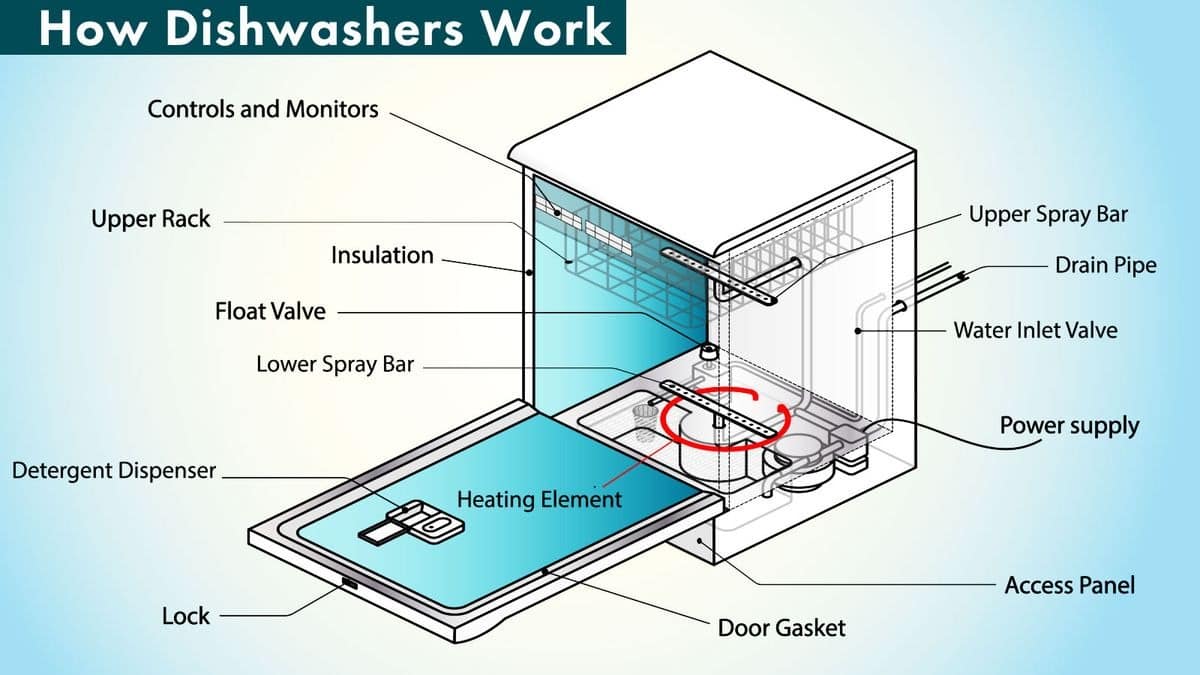For those inquisitive, let’s define a built-in dishwasher. It is a major kitchen appliance that specialists permanently install into your cabinetry. Manufacturers often place it near the kitchen sink for easy plumbing connections and dishwashing. This contrasts with countertop or portable dishwashers, which you can place on your countertop or move around, and they generally connect to a tap.
Built-in dishwashers are designed to match your kitchen’s style. Front panels can match your cabinet finish or be custom made to match your kitchen’s design theme—modern, traditional, or something unique. This integration saves floor and countertop space and gives your kitchen a sleek, consistent design.
Built-in dishwashers also have complex functions and settings that can accommodate everything from delicate stemware to hefty pots and pans, making them essential for anyone who loves cooking but hates cleaning. They have a bigger capacity than portable or countertop models, making them perfect for families or regular entertainers. With energy-efficient models, they may help your household save water and energy, making it greener.
The design and functionality of a built-in dishwasher are thoughtfully integrated into your kitchen, bringing convenience, efficiency, and elegance to your daily life.

Built-in dishwashers are available in a variety of sizes to accommodate different kitchen spaces and loads of dishes. They come in standard widths of 18 inches, 24 inches, and sometimes 30 inches. The height and depth can vary as well, but they are usually designed to fit under the standard kitchen countertop.
Advantages of Built-in Dishwasher
One of the key advantages of a built-in dishwasher is its convenience and efficiency in cleaning dishes. Once installed, you can easily load and unload dishes by just opening the dishwasher door; there is no need to move it around like a portable dishwasher. This saves you time and effort in washing your dishes manually.
Built-in dishwashers come with multiple wash cycles and settings to suit different types of loads and dishes. They often include features such as adjustable racks, silverware baskets, delay start options, and energy-saving modes. Advanced sensors monitor soil levels and modify the wash cycle for best cleaning in some models.

Another benefit of built-in dishwashers is their noise levels. Insulation, improved motors, and soundproofing make many modern washers quiet during the wash cycle. This is especially important in open-concept kitchen layouts where noise from the dishwasher can be disruptive.
Concerning installation, a built-in dishwasher requires professional help to ensure proper placement, connections, and functionality. It must be tied into the kitchen’s water and drainage system and electricity supply. Many households find the initial installation cost justifiable due to its long-term convenience and efficiency.
In summarization, a built-in dishwasher is a permanent and integral part of a modern kitchen, offering convenience, efficiency, and a polished look. With a wide range of sizes, features, and designs available in the market, you can find a built-in dishwasher that fits your kitchen space and meets your dishwashing needs. Consider this appliance for your kitchen upgrade to enjoy hassle-free dish cleaning on a daily basis.
 https://bistrovivant.com is a participant in the Amazon Services LLC Associates Program, an affiliate advertising program designed to provide a means for website owners to earn advertising fees by advertising and linking to Amazon (.com,.co.uk,.ca, etc.) and any other website that may be affiliated with the Amazon Service LLC Associates Program. As an Amazon Associate, I earn from qualifying purchases.
https://bistrovivant.com is a participant in the Amazon Services LLC Associates Program, an affiliate advertising program designed to provide a means for website owners to earn advertising fees by advertising and linking to Amazon (.com,.co.uk,.ca, etc.) and any other website that may be affiliated with the Amazon Service LLC Associates Program. As an Amazon Associate, I earn from qualifying purchases.

